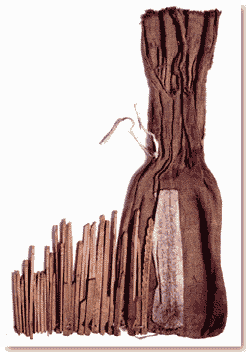
Tally sticks of Aug. 1316 to Sept. 1317
Tally Sticks
Tallies in a canvas bag, the accounts of Richard de Wigornia, keeper of the king's mines in Devon, Aug. 1316 to Sept. 1317.
Tally sticks were narrow shafts of wood, normally hazel, used as receipts
for money, the amount being indicated by notches. According to the ![]() Dialogue of the Exchequer, the tally was to be "the distance
between the tip of the forefinger and the thumb when fully extended
. . The manner of cutting is as follows. At the top of the tally a cut
is made, the thickness of the palm of the hand, to represent a thousand
pounds; then a hundred pounds by a cut the breadth of a thumb; twenty
pounds, the breadth of the little finger; a single pound, the width
of a swollen barleycorn; a shilling rather narrower than a penny is
marked by a single cut without removing any wood". After the tally
was cut, the shaft was split lengthways into two pieces of unequal length,
both bearing the same notches. The longer piece, known as the stock,
was normally given to the payer and the shorter, the foil, was kept
by the payee. When the accounts were audited the two pieces were fitted
together to see if they would "tally". Private tallies were
also kept by accountants who were not Exchequer officials, such as those
illustrated here.
Dialogue of the Exchequer, the tally was to be "the distance
between the tip of the forefinger and the thumb when fully extended
. . The manner of cutting is as follows. At the top of the tally a cut
is made, the thickness of the palm of the hand, to represent a thousand
pounds; then a hundred pounds by a cut the breadth of a thumb; twenty
pounds, the breadth of the little finger; a single pound, the width
of a swollen barleycorn; a shilling rather narrower than a penny is
marked by a single cut without removing any wood". After the tally
was cut, the shaft was split lengthways into two pieces of unequal length,
both bearing the same notches. The longer piece, known as the stock,
was normally given to the payer and the shorter, the foil, was kept
by the payee. When the accounts were audited the two pieces were fitted
together to see if they would "tally". Private tallies were
also kept by accountants who were not Exchequer officials, such as those
illustrated here.
Such tallies continued in use by the Exchequer until 1826, with very large tally sticks used to record significant sums. It was the burning of obsolete tally sticks in 1834 that led to the burning of the old Houses of Parliament and their replacement by the present largely Victorian edifice.
The structural ironwork on the walkway between the two ponds on the present Public Record Office site at Kew reflects the notched tally stick in its design.